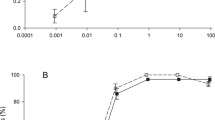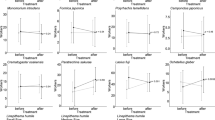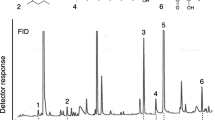Abstract
Argentine ant trail pheromone disruption, using continuous release of the trail pheromone compound (Z)-9-hexadecanal, reduces the incidence of trails and foraging rates of field populations. However, little is known about the concentrations of pheromone required for successful disruption. We hypothesized that higher pheromone quantities would be necessary to disrupt larger ant populations. To test this, we laid a 30-cm long base trail of (Z)-9-hexadecanal on a glass surface at low and high rates (1 and 100 pg/cm) (Trail 1), and laid a second, shorter trail (Trail 2, 10 cm long, located 1.5 cm upwind) near the middle of Trail 1 at six rates (1, 10, 100, 1,000, 10,000, and 100,000 pg/cm). We then recorded and digitized movements of individual ants following Trail 1, and derived a regression statistic, r 2, as an index of trail integrity, and also recorded arrival success at the other end of the trail (30 cm) near a food supply. Disruption of trails required 100 fold more pheromone upwind, independent of base-trail concentration. This implies that in the field, trail disruption is likely to be less successful against high ant-trail densities (greater concentration of trail pheromone), and more successful against newly formed or weak trails, as could be expected along invasion fronts.




Similar content being viewed by others
References
Aron, S., Keller, L., and Passera, L. 2001. Role of resource availability on sex, caste and reproductive allocation ratios in the Argentine ant Linepithema humile. J. Anim. Ecol. 70:831–839.
Banks, W. A., Lofgren, C. S., Jouvenaz, D. P., Stringer, C. E., Bishop, P. M., Williams, D. F., Wojcik, D. P., and Glancey, B. M. 1981. Techniques for collecting, rearing, and handling imported fire ants. USDA, SEA, AATS-S-21, 9 p.
Bartell, R. J. 1982. Mechanisms of communication disruption by pheromone in the control of Lepidoptera: A review. Physiol. Entomol. 7:353–364.
Bartell, R. J. and Lawrence, L. A. 1973. Reduction in responsiveness of males of Epiphyas postvittana (Lepidoptera) to sex pheromone following previous brief pheromonal exposure. J. Insect Behav. 19:845–855.
Brown, W. L. 1961. Mass insect control programs: Four case histories. Psyche 68:76–109.
Cavill, G. W. K., Robertson, P. L., and Davies, N. W. 1979. An Argentine ant Iridomyrmex humilis aggregation factor. Experientia (Basel) 35:989–990.
Deneubourg, J. L., Aron, S Goss, S., and Pasteels, J. M. 1990. The self-organizing exploratory pattern of the Argentine ant. J. Insect Behav. 3:159–168.
El-Sayed, A. M. 2011. The Pherobase: Database of Insect Pheromones and semiochemicals. http://www.pherobase.com. Accessed May 1 2011.
Evershed, R. P., Morgan, E. D., and Cammaerts, M. C. 1982. 3-Ethyl-2,5-dimethylpyrazine, the trail pheromone from the venom gland of eight species of myrmica ants. Insect Biochem. 12:383–391.
Greenberg, L., Klotz, J. H., and Rust, M. K. 2006. Liquid borate bait for control of the Argentine ant, Linepithema humile, in organic citrus (Hymenoptera: Formicidae). Fla. Entomol. 89:469–474.
Greenberg, L., and Klotz, J. H. 2000. Argentine ant (Hymenoptera: Formicidae) trail pheromone enhances consumption of liquid sucrose solution. J. Econ. Entomol. 93:119–22.
Hangartner, W. 1967. Specificity and inactivation of trail pheromone in Lasius fuliginosus Latr. and orientation of ant workers in scent field. Zeitsch. Vergleich. Physiol. 57:103–136.
Hooper-Bui, L. M. and Rust, M. K. 2000. Oral toxicity of abamectin, boric acid, fipronil, and hydramethylnon to laboratory colonies of Argentine ants (Hymenoptera: Formicidae). J. Econ. Entomol. 93:858–864.
Jackson, D. E. and Châline, N. 2007. Modulation of pheromone trail strength with food quality in Pharaoh’s ant, Monomorium pharaonis. Anim. Behav. 74:463–470.
Klotz, J., Greenberg, L., and Venn, E. C. 2000. Evaluation of two hydramethylnon granular baits for control of Argentine ant (Hymenoptera: Formicidae). Sociobiology 36:201–207.
Krushelnycky, P. D. and Reimer, N. J. 1998. Efficacy of Maxforce bait for control of the Argentine ant (Hymenoptera: Formicidae) in Haleakala National Park, Maui, Hawaii. Environ. Entomol. 27:1473–1481.
Lowe, S., Browne, M., Boudjelas, S., and De Poorter, M. 2000. 100 of the world’s worst invasive species. Aliens 12:s1-s12.
Minks, A. K. and Cardé, R. T. 1988. Disruption of pheromone communication in moths: is the natural blend really most efficacious? Entomol. Exp. Appl. 49:25–36.
Morgan, E. D., Keegans, S. J., Tits J., Wenseleers, T., and Billen, J. 2006. Preferences and differences in the trail pheromone of the leaf-cutting ant Atta sexdens sexdens (Hymenoptera: Formicidae). Eur. J. Entomol. 103:553–558.
Nesbitt, B. F., Beevor, P. S., Hall, D. R., Lester, R., and Dyck, V. A. 1975. Identification of the female sex pheromones of the moth, Chilo suppressalis. J. Insect Physiol. 21:1883–1886.
Nishisue, K., Sunamura, E., Tanaka, Y., Sakamoto, H., Suzuki, S., Fukumoto, T., Terayama, M., and Tatsuki, S. 2010. Long-term field trial to control the invasive argentine ant (Hymenoptera: Formicidae) with synthetic trail pheromone. J. Econ. Entomol. 103: 1784–1789.
Rumbo, E. R. and Vickers, R. A. 1997. Prolonged adaptation as a possible mating disruption mechanism in Oriental fruit moth,Cydia (=Grapholitha) molesta. J. Chem. Ecol. 23: 445–457.
Schofield, S. W., Justus, K. A., Mafra-Neto, A., and Cardé. R, T. 2003. Flight of male Cadra cautella along plumes of air and pheromone superimposed on backgrounds of pheromone. Entomol. Exp. Appl. 109:173–181.
Suckling, D. M., Peck, R. W., Manning, L. M., Stringer, L. D., Cappadonna, J., and El-Sayed, A. M. 2008. Pheromone disruption of Argentine ant trail integrity. J. Chem. Ecol. 34:1602–1609.
Suckling, D. M., Peck, R. W., Stringer, L. D., Snook, K., and Banko, P. C. 2010a. Trail pheromone disruption of Argentine ant trail formation and foraging. J. Chem. Ecol. 36:122–128.
Sunamura, E., Suzuki, S., Nishisue, K., Sakamoto, H., Otsuka, M., Utsumi, Y., Mochizuki, F., Fukumoto, T., Ishikawa, Y., Terayama, M., and Tatsuki, S. 2011. Combined use of a synthetic trail pheromone and insecticidal bait provides effective control of an invasive ant. Pest Man. Sci.: early online.
Tanaka, Y., Nishisue, K., Sunamura, E., Suzuki, S., Sakamoto, H., Fukumoto, T., Terayama, M., and Tatsuki, S. 2009. Trail-following disruption in the invasive Argentine ant with a synthetic trail pheromone component (Z)-9-hexadecenal. Sociobiology 54:139–152.
Tatsuki, S., Teryama, M., Tanaka, Y., and Fukumoto, T. 2005. Behavior-disrupting agent and behavior disrupting method of Argentine ant. Patent pub. no. US2005/0209344A1.
Van Vorhis Key, S. E., Gaston, L. K., and Baker, T. C. 1981. Effects of gaster extract trail concentration on the trail following behavior of the Argentine ant, Iridomyrmex humilis (Mayr). J. Insect Physiol. 27:363–370.
Van Vorhis Key, S. E. and Baker, T. C. 1982a. Specificity of laboratory trail following by the Argentine ant, Iridomyrmex humilis (Mayr), to (Z)-9-hexadecenal, analogs, and gaster extract. J. Chem. Ecol. 8:1057–1063.
Van Vorhis Key, S. E. and Baker, T. C. 1982b. Trail-following responses of the Argentine ant, Iridomyrmex humilis (Mayr), to a synthetic trail pheromone component and analogs. J. Chem. Ecol. 8:3–14.
Van Vorhis Key, S. E. and Baker, T. C. 1982c. Trail pheromone-conditioned anemotaxis by the Argentine ant, Iridomyrmex humilis. Entomol. Exp. Appl. 32:232–237.
Van Vorhis Key, S. E. and Baker, T. C. 1986. Observations on the trail deposition and recruitment behaviors of the Argentine ant, Iridomyrmex humilis (Hymenoptera: Formicidae). Ann. Entomol. Soc. Am. 79:283–288.
van Wilgenburg, E., Torres, C. W. and Tsutsui, N. D. 2010. The global expansion of a single ant supercolony. Evol. Applic. 3:136–143.
Wall, C. and Perry, J. N. 1981. Effects of dose and attractant on interactions between pheromone traps for the pea moth, Cydia nigricana. Entomol. Exp. Appl. 30: 26–30.
Witzgall, P., Kirsch, P., and Cork, A. 2010. Sex pheromones and their impact on pest management. J. Chem. Ecol. 36:80–100.
Zhakharov, A. A. and Thompson, L. C. 1998. Effects of repeated use of fenoxycarb and hydramethylnon baits on nontarget ants. J. Entomol. Sci. 33:212–220.
Acknowledgements
Funding was provided by the New Zealand Ministry for Science and Innovation (CO6X0811 and C06X0601). We thank members of our advisory panel Dr. Chris Green (Dept. of Conservation), Mr. M. Harre (Ministry of Agriculture and Fisheries) and Dr. Nick Waipara (Auckland Regional Council) for support. Dr Alisdair Noble provided statistical advice.
Author information
Authors and Affiliations
Corresponding author
Electronic Supplementary material
Below is the link to the electronic supplementary material.
Supplemental Fig. A
Experimental layout of glass (solid rectangle) and synthetic (Z)-9-hexadecenal trails, with actual ant trail (on Trail 1; no trail 2 present) overlaid, to show walking behavior (close up on left). Trail 1 was tested at two concentrations and Trail 2 was tested at six concentrations and an untreated control. (DOCX 124 kb)
Rights and permissions
About this article
Cite this article
Suckling, D.M., Stringer, L.D. & Corn, J.E. Argentine Ant Trail Pheromone Disruption is Mediated by Trail Concentration. J Chem Ecol 37, 1143–1149 (2011). https://doi.org/10.1007/s10886-011-0019-0
Received:
Revised:
Accepted:
Published:
Issue Date:
DOI: https://doi.org/10.1007/s10886-011-0019-0




